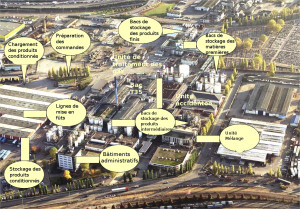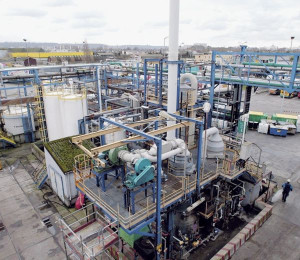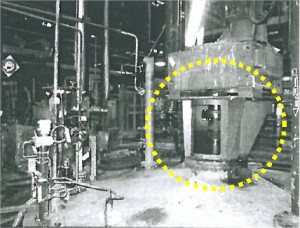Around 8:00 a.m., an operator smelled mercaptans (strong-smelling gas < 1 ppb, toxic in high concentrations) in the zinc dialkyldithiophosphate (ZDDP) unit of a site that manufactures lubricant additives. He collected a sample of mercaptan that had been sitting in the adjustment tank for two days awaiting transfer when the high-temperature alarm went off in the control room. Around 9:00 a.m., analyses confirmed that the mercaptan had thermally decomposed. An inerting test involving the addition of a mixture of zinc oxide and water failed at around 11:00 a.m. because of technical difficulties that delayed preparation of the neutralisation mixture in a mobile mixer (plug/socket connection issues, mixture prepared too quickly). The gas treatment system at the unit overloaded, allowing a strong-smelling cloud of gas to drift off site. At 10:00 a.m., the plant operator implemented the internal emergency plan and informed the regional prefecture at around 11:30 a.m. Thirty-three communities were alerted via various emergency alerts. Neutralization tests conducted in the late evening failed. The wind then shifted, blowing the smell south-east to the Paris area and north-west over the Channel and towards the south of England during the night. Tens of thousands of people were bothered by the unpleasant aroma, with some complaining of nausea, headache and vomiting. Emergency services responded to over 20 calls in the Rouen area. The prefect put together an information team on Tuesday morning and implemented an external emergency plan at 10:35 a.m. From Wednesday morning to Friday evening, a new method made it possible to 'safely' neutralise the 36 tonnes of decomposing mercaptan in batches of 12 tonnes and haul it by lorry to an incineration plant. According to upper bound calculations, the decomposition released 95 kg of hydrogen sulphide, which was eliminated by the treatment system, and 545 kg of mercaptans that were not totally treated (272 kg released into the air). The accident received extensive media attention in France and abroad due to the area covered by the gas cloud. The tank was rinsed and the external emergency plan was ended on 6 February. The operating losses are temporarily estimated at several hundred thousand euros (plant shut down for the duration of the accident, ZDDP shop shut down for three months afterwards).
Multiple causes were identified:
- On Friday 18 January, an operator mistakenly turned on the adjustment tank’s mixer instead of the recirculation pump via the unit’s control panel. A batch of mercaptan at 94 °C, transferred to the tank on Saturday morning, gradually heated up until Monday morning, the day when the thermal decomposition was discovered (T > 110 °C). The operators assigned to performing weekend rounds failed to notice that the mixer was operating although the light on the panel was lit and the shaft at the top of the tank could be seen rotating.
- The filling of a storage tank and lack of demand for mercaptan prompted the plant operator to store the batch of mercaptan in an adjustment tank. However, the tank’s transfer and recirculation systems were operating only in manual mode after an instrumented safety system disabled the pump’s remote controls to prevent the storage tank being overfilled.
- Without a change management procedure being implemented, the tank had been transferred from another unit 16 years earlier along with a mixer and thermal insulation not required for the process.
- It was atypical for the pump to be turned on manually. Although the mixer had been decommissioned in 2006, it was turned back on by mistake following a poorly supervised maintenance visit.
- The mixer’s operation was not relayed to the control room and the shift operators had not been given specific instructions to manually turn on or visually check the mixer.
- The risk analysis did not identify the risk of slow decomposition of the ZDDP around 110 °C.
- In the control room, the temperature in the adjustment tank was checked only occasionally, i.e. when the recirculation pump was turned on before manual sampling.
- The treatment implemented merely stabilised the decomposition reaction, but did not stop it.
- The gas treatment system, sized for a massive release of hydrogen sulphide (conservative toxic scenario), overloaded quickly when the mercaptan emissions exceeded trace levels.
The operator removed the thermal insulation from the tank, fitted cooling devices that are available within 15 minutes, modernised the unit’s control system (mimic displays and hierarchical alarms for continuous monitoring of the temperature and hydrogen sulphide/mercaptan levels in the stack, increased the reliability and redundancy of the temperature measurements, etc.) and resized the gas treatment system for massive mercaptan releases. It also improved the monitoring and response procedures for exceptional circumstances, increased its employees’ awareness of and training in handling emergencies, analysed the retrofits to other equipment installed 16 years earlier, and improved equipment inspection and testing procedures.
Download the detailed report in .pdf format (1.1 Mb)






